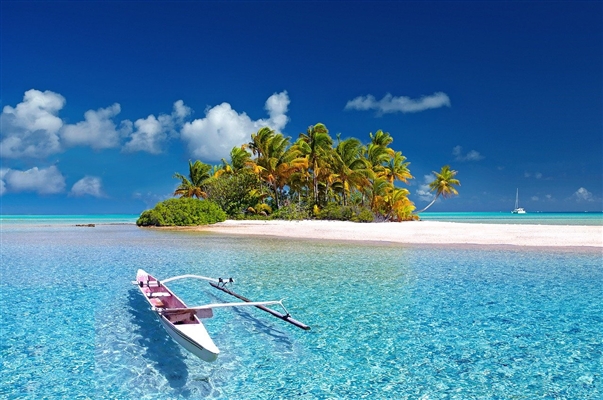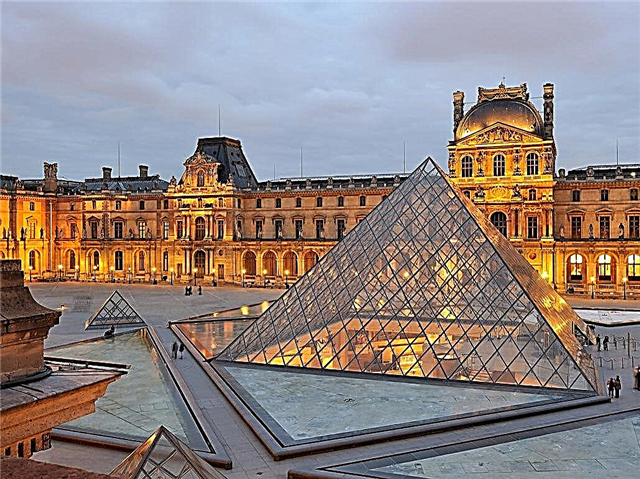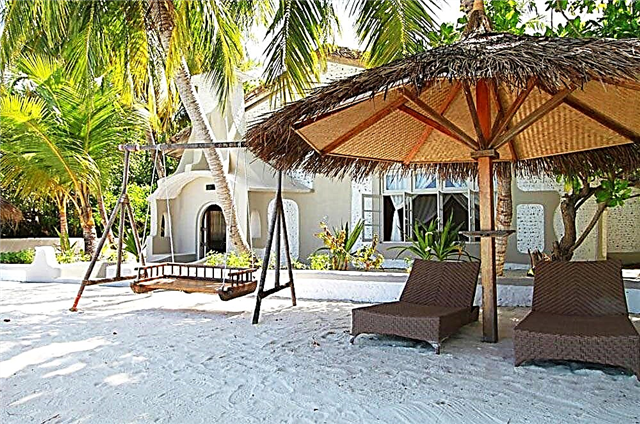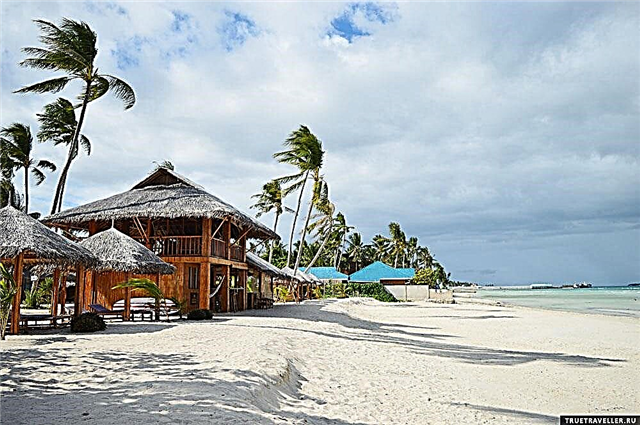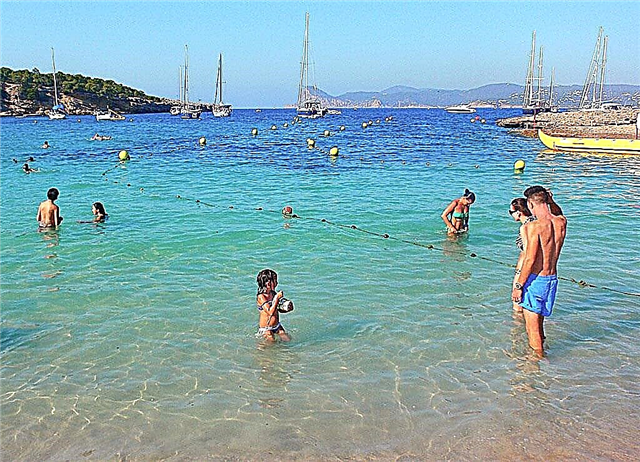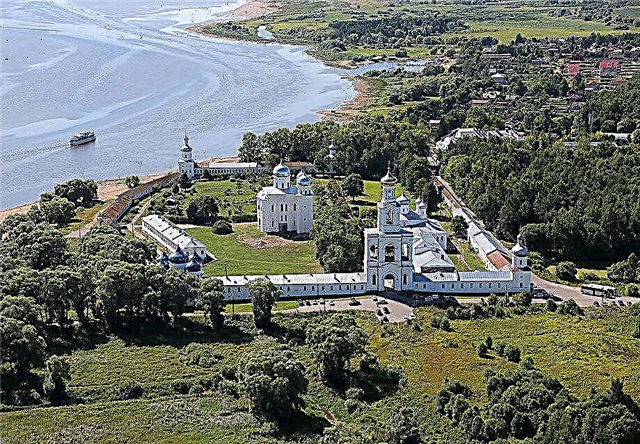Monasteries of the Novgorod region are an integral part of the cultural values of Russia. Orthodox pilgrims strive here to worship shrines in the form of healing icons, ancient frescoes, and the relics of the righteous. Monasteries for men and women are located both within the city and beyond.
Tourists get acquainted with interest with the iconic old buildings. The history of their creation, the impressive facades and interiors of buildings are of interest. On the spacious territories of the cloisters there are church buildings with the main cathedral. Here solemn liturgies are held on the days of Orthodox festivities, as well as the sacraments of weddings and baptisms.
Monasteries of Veliky Novgorod and Novgorod Region
The most famous active Orthodox male and female monasteries. Holy places, list, photos with names and descriptions!
St. George's Monastery
The wooden building of the monastery appeared in 1030. It was erected in honor of George the Victorious, but in the Old Russian language a simplified form of this name was adopted - Yuri. Therefore, the monastery began to be called Yuryev. One of the oldest church buildings in Russia, 100 years later, thanks to the efforts of the builders, turned into a stone one. Since then, the monastery almost retains its appearance and fascinates with the harmony of proportions and grandeur.
Address: Veliky Novgorod, Yurievskoe highway, 10
Site: georg.orthodoxy.ru

Holy Spirit Monastery
Monastery in Borovichi. Its appearance dates back to 1162. First, the monastery was built of wood. In the middle of the XIV century, it expanded at the expense of the stone temple of the Holy Spirit, later other religious buildings appeared on the territory. Since the post-revolutionary 20s of the XX century, the monastery complex was considered inactive. In our time, its buildings are also the churches - the Trinity, the Holy Spirit.
Address: Borovichi, st. A. Nevsky, 6
Site: boreparhia.ru

Valdai Iversky Monastery
The monastery was built on the Selvitsky Island of Valdai Lake in 1653. Patriarch Nikon ordered it to be erected. His Holiness laid the foundation stone for the lavra. Its center was the Assumption Cathedral, where the icon of the Iberian Mother of God has been preserved. The iconostasis, massive oak doors in tiles, preserved the ancestor for posterity. The craftsmen who built the New Jerusalem Monastery worked on their creation.
Address: Valdai Lake, Selvitsky Island
Site: iveron.ru

Nikolo-Vyazhischsky monastery
The female abode is stavropegic. Its appearance in the XIV century was blessed by the priest Pimen and the monks Ignatius, Galaktion, Euphrosynus. In 1411, a church was built in the monastery on the spot where Nicholas the Wonderworker appeared to the believers. Today, in the spiritual cradle of the Monk Euthymius II, Archbishop of Novgorod, many holiness have been preserved. This is his burial place and particles of the remains - Nicholas the Wonderworker, the righteous Anthony the Roman of Novgorod and the blessed Matrona of Moscow.
Address: v. Vyazhischi
Site: n-v-m.cerkov.ru

Nikolo-Kosinsky monastery
The monastery was founded as a male monastery in the 13th century with the assistance of the monks Constantine and Cosmas. Then a wooden laurel was erected. Temples in stone, ravaged during the Time of Troubles, were rebuilt in the 1620s, and in 1764 they were converted to a parish. The women's almshouse was established in 1885, and a women's monastery appeared in 1896. Closed in 1920 and damaged in the Second World War, the complex today pleases with the restored church in the name of St. Nicholas.
Address: D. Kosino

Mikhailo-Klopsky monastery
The location of the monastery is on the coast of the Veryazha River. The Lavra was first mentioned in 1408, which is associated with the first arrival of St. Mikhail Klopsky. Four years later, a wooden Trinity Church on Klopsk was erected on the monastery territory, and a stone one after five years. In 1569, at the behest of Ivan IV the Terrible, the temple was dismantled, and a large cathedral appeared in its place. In a rebuilt form, it has survived to this day.
Address: village Seltso
Website: www.klopsky.ru

Varlaam-Khutynsky monastery
The monastery appeared thanks to St. Varlaam Khutynsky in the XII century in a "bad place". But the power of evil forces disappeared after the prayers of the righteous. First, the Church of the Transfiguration of the Savior was built. In the XVI-XIX centuries, an architectural complex with a holy hill with a chapel named after the blessed, a holy well arose. The relics of St. Barlaam, G.R.Derzhavin, a Russian poet, is buried in the vestibule of the Apostle John the Theologian.
Address: village Khutyn
Site: vk.com/club6436531

Holy Trinity Nikandrov Monastery
Monk Nikandr Gorodnoezersky founded the desert in the 17th century. When the Church of the All-Merciful Savior burned down, a chapel was built in its place. By order of Tsarina Catherine II, the monastery was abolished, the stone church was built in the 20s of the 19th century. It was consecrated in 1831 in the name of the Holy Trinity. Under the Bolsheviks, the temple fell into disrepair. The monastery was being restored already in the 21st century, and since the summer of 2002 liturgies have been held in the church.
Address: s. Nikandrovo
Site: nikandrovmonastyr.ru

Anthony-Leokhnovsky Monastery
There has been a laurel on the Volkhov River since 1106 thanks to the Monk Anthony and Bishops Nikita and Niphont. The erected stone cathedral in 1125 was painted with frescoes. In the 17th century, the monastery was ravaged by the Swedes, and began to restore it in 1630. Then the remains of St. Anthony. In 1788, the church building burned down, and a new church was erected in its place. After 1917, the monastery was closed, it was restored only in 1991.
Address: village Leokhnovo
Website: vk.com/leohnovomonastyr

Perynsky skete
The desert in the Peryn valley was named after the god Perun, in whose honor a pagan sanctuary was erected here in the past. In 995, a wooden Orthodox church was built on this site. It was mentioned in the annals of 1386 as burnt. The stone church of the Nativity of the Virgin was erected in the 13th century from limestone and thin bricks. The monastery founded later in 1611 was ruined by the Swedes. A tall church building has survived to this day.
Address: village Yuryevo

Inactive monasteries
Monuments of church architecture - abandoned and restored monasteries.
Zverin-Pokrovsky Monastery
For the first time the monastery wooden church of the Intercession was mentioned in the chronicles in 1148, when it was already destroyed by lightning. The buildings of the Zverin Monastery that appeared later were closed in 1721, but after 6 years they were restored. In the 18th century, this and the Nikolo-Belsky monasteries merged. In 1899, the monastery was replenished with the Intercession Cathedral. With the arrival of the Bolsheviks, the monastery was closed. The cathedral was returned to the believers in 1989.
Address: Veliky Novgorod, st. Bredova-Zverinaya, 18
Website: www.soborpokrova.ru

Derevyanitsky monastery
The name comes from the Derevianka river, where the monastery stands. Its first mention in the annals is in 1335, when the Church of the Resurrection of Christ in stone was built in stone by order of St. Moses. At the end of the 17th century, the rebuilt church building collapsed, and the Resurrection Cathedral appeared in its place. Later, the territory of the monastery was decorated with a stone-laid church of the Assumption of the Virgin.
Address: Vostochnaya, 3

Old Russian Spaso-Preobrazhensky Monastery
The Lavra was created in 1192 by Abbot Martyrius. After 6 years, the built wooden Cathedral of the Transfiguration of the Savior burned down, a new one was rebuilt in stone in 1442. Its iconostasis, in 5 tiers, is in the Byzantine style. The church interior was decorated with the miraculous icon of the Mother of God. The monastery contains parts of the holy relics of 50 saints. Until 1630, churches were erected on the monastery territory - the Nativity of Christ and the Meeting of the Lord.
Address: Staraya Russa, Monastyrskaya square, 1

Tithes Monastery
The monastery is one of the oldest in Novgorod. The foundation of the desert dates back to the beginning of the XIV century, when the church of St. Theotokos. In 1397, the Church of the Nativity of the Virgin was erected, and in 1413 - the Church of John the Baptist (it is in stone). Gradually, cells-walls made of stone, a crypt, a refectory appeared in the monastery.In 1809, a belfry was erected in stone, and rebuilt in 1903. And today it crowns the monastery ensemble.
Address: Veliky Novgorod, Desyatin Monastery, 3

Rdeysky Assumption Monastery
At first, there was a Preobrazhensky monastery on the peninsula of Lake Rdeyskoye. It also included monasteries - Troitskaya and Nikolo-Khvoinskaya. The monastery was abolished in 1764, in 1886 a women's community was established, turned into a desert in 1893. It was closed during the Soviet period. Today, in the monastery's Assumption Cathedral, the unique iconostasis of white marble with ornate carvings has been partially preserved.
Address: Reserve Rdeyskoe Lake



